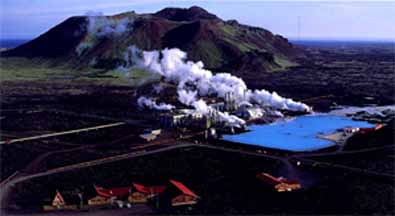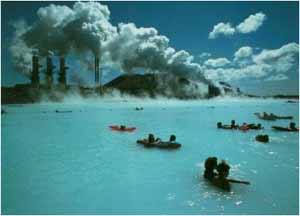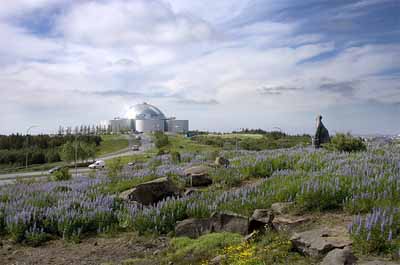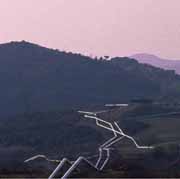

The Svartsengi Geothermal Plant and the Blue
Lagoon. Source: Thorolfsson 2005
The Svartsengi Geothermal Plant with swimming in the Blue Lagoon. Photo by P. Stefánsson. Source: International Geothermal Association Photo Gallery
Geothermal Contributes to Place Making
Geothermal features such as geysers, vents, and hot springs have always contributed to place making. Hot springs have been sacred places for many indigenous peoples throughout history. The importance of geothermal springs in place making can be seen by the numerous places barring the name Hot Springs, Warm Springs, and even Hot Lake. Warm Springs Avenue in Boise was named after Kelly Hot Springs which provides the water for the geothermal heating district. The construction of the heating district and the Natatorium contributed to making Warm Springs Boise’s finest neighborhoods full of grand homes. The neighborhood is now preserved as a historic district. From heated swimming pools to greenhouses to heated pavements for snow-melting, geothermal energy shows its presence in the landscape.
 |
 |
The Svartsengi Geothermal Plant and the Blue |
The Svartsengi Geothermal Plant with swimming in the Blue Lagoon. Photo by P. Stefánsson. Source: International Geothermal Association Photo Gallery |
The Svartsengia power plant is built on a lava field. Silica in the effluent has made a near watertight seal over the permeable lava at the bottom of a trough allowing the formation of the Blue Lagoon. The geothermal waters have medicinal benefits and can treat psoriasis and other forms of eczema. The spa has developed a line of skin care products from the mineral rich water.
Reykjavik has made its geothermal infrastructure into gathering places and tourist attractions. Perlan, (meaning Pearl in English) combines water storage with a museum, fine restaurant, and observation deck.
 |
Perlan (the Perl). Source www.perlan.is |
Perlan sits atop Oskjuhlid, one of the city’s highest hills, and an important green space and recreational area for the city. The forested hill includes bike paths and walkways. The Perlan includes six aluminum-sided tanks, each of which contain 4 million liters of water averaging 85°C (185°F), with a glass dome in the center. On the top floor is a revolving restaurant and in a decommissioned tank is the Saga Museum. The viewing deck offers wonderful panoramic views of the city (http://www.perlan.is).
The utilization of geothermal resources can change the landscape in other ways. Fish farms and raceways are a common industrial application and a distinctive landscape feature. Heated greenhouses are another.
 |
| Geothermal infrastructure in Larderello, Italy. Photo by Maurizio Plutino, Flikr.com |
Larderello Italy began exploiting its dry steam field industrially in the early 19th Century by harvesting boric acid from the geothermal water. In 1827 Francesco Larderel developed a system for using geothermal heat in the boric water to extract the acid through evaporation. In 1904 the first geothermal power plant was built there. As the geothermal industry has grown over the last century “the network of pipelines criss-crossing the countryside and the powerplant cooling towers have become an integral part of the panorama and are indeed a famous tourist attraction” (Dickson and Fanelli 2004, 54).